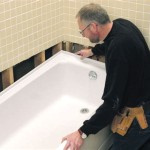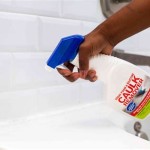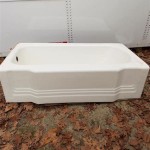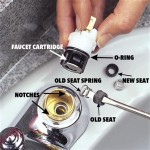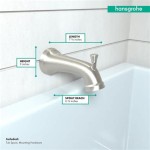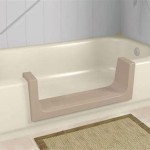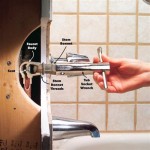How To Clean Bathtub Stains
Bathtub stains are a common household nuisance. Mineral deposits from hard water, soap scum buildup, and rust can all contribute to unsightly marks that detract from the overall cleanliness and appeal of a bathroom. Addressing these stains promptly and effectively not only improves the aesthetics of the bathtub but also helps prevent long-term damage and the need for more extensive cleaning efforts later on. The following details diverse strategies for tackling bathtub stains, utilizing both readily available household products and specialized cleaning agents.
Identifying the Type of Stain
Before embarking on a cleaning regimen, accurately identifying the type of stain is crucial. Different types of stains require different approaches for optimal removal. Common bathtub stains include soap scum, hard water stains, rust stains, and mold or mildew stains.
Soap scum typically presents as a dull, white or gray film that clings to bathtub surfaces. It is composed of the residue left behind by soap products reacting with minerals found in hard water. This type of stain is often concentrated around areas that frequently come into contact with bathwater, such as the waterline and the bottom of the tub.
Hard water stains are caused by mineral deposits, primarily calcium and magnesium, left behind when hard water evaporates. These stains often appear as white or chalky deposits on the bathtub surface, particularly around faucets and drains. Over time, if left untreated, hard water stains can become quite stubborn and difficult to remove.
Rust stains manifest as reddish-brown discolorations. These stains typically originate from iron-rich water or from metal fixtures in the bathroom, such as showerheads or drain components, that are beginning to corrode. Rust stains tend to be more persistent than soap scum or hard water stains and may require specialized cleaning agents to effectively eliminate them.
Mold or mildew stains are characterized by dark, often black or green, patches. These stains thrive in moist environments, such as bathrooms, and are caused by fungal growth. Mold and mildew can not only be unsightly but can also pose health risks, making their prompt removal essential. Identifying the specific type of stain will allow for the most effective cleaning method to be chosen.
Household Cleaning Solutions
Many common household products can be employed to effectively clean bathtub stains. These solutions are often readily available and offer a cost-effective alternative to specialized cleaning agents. Some examples include baking soda, vinegar, lemon juice, and hydrogen peroxide.
Baking soda is a mild abrasive and deodorizer that can be used for a variety of cleaning tasks. For soap scum buildup, a paste can be created by mixing baking soda with water. This paste is then applied to the stained area, allowed to sit for several minutes, and scrubbed with a sponge or brush before rinsing with water.
Vinegar, particularly white vinegar, is an effective acid-based cleaner that can dissolve mineral deposits and soap scum. It can be used to tackle hard water stains. Vinegar can be diluted with water in a spray bottle and applied to the stained areas. After allowing it to sit for approximately 15 to 30 minutes, the surface can be scrubbed and rinsed clean.
Lemon juice, another acid-based cleaner, can be used similarly to vinegar. Its natural acidity helps to break down mineral deposits and soap scum. The juice from fresh lemons can be applied directly to the stains, allowed to sit for a period of time, and then scrubbed and rinsed.
Hydrogen peroxide is a mild bleaching agent that can be effective at removing various types of stains, including mold and mildew. It can be sprayed directly onto the affected areas and left to sit for several minutes before scrubbing and rinsing. When using hydrogen peroxide, proper ventilation is important.
When using any cleaning solution, it is recommended to test it on an inconspicuous area of the bathtub first to ensure it does not cause discoloration or damage to the surface. Furthermore, ensure proper ventilation while cleaning.
Specialized Cleaning Products
When household solutions prove ineffective, specialized cleaning products formulated for bathtub stains may be necessary. These products often contain stronger chemicals designed to tackle stubborn stains and require careful handling. Examples include commercially available bathroom cleaners, rust removers, and mold and mildew killers.
Bathroom cleaners are specifically formulated to remove soap scum, hard water stains, and other common bathroom grime. They typically contain a combination of surfactants, solvents, and acids to effectively dissolve and lift away stains. When using bathroom cleaners, it is important to follow the manufacturer's instructions carefully and to ensure proper ventilation.
Rust removers are designed to specifically target rust stains. These products often contain chemicals, such as oxalic acid or phosphoric acid, that react with the rust molecules to break them down and dissolve them. When using rust removers, it is essential to wear gloves and eye protection to prevent skin and eye irritation. It's also crucial to avoid prolonged contact with the bathtub surface to prevent damage.
Mold and mildew killers are formulated to eliminate mold and mildew growth. These products typically contain bleach or other antimicrobial agents that kill the fungi and prevent them from returning. When using mold and mildew killers, adequate ventilation is absolutely critical. It is important to follow the manufacturer's instructions and to wear protective gear, such as gloves and a mask.
Before using any specialized cleaning product, it is imperative to read the label carefully and to understand the potential risks associated with its use. Ensure proper ventilation in the bathroom during application and wear appropriate protective gear to prevent skin and eye irritation. Testing the product on an inconspicuous area is still advisable, to ensure compatibility with the bathtub material.
Scrubbing Tools and Techniques
The choice of scrubbing tools and the application of proper scrubbing techniques can significantly impact the effectiveness of stain removal. Using the right tools and techniques can help to avoid damaging the bathtub surface while maximizing cleaning power. Utilizing appropriate tools and techniques for effective and safe stain removal is essential.
Sponges are versatile cleaning tools that can be used for general scrubbing. Non-abrasive sponges are recommended to avoid scratching the bathtub surface. For more stubborn stains, a scrubbing brush with stiff bristles may be necessary. However, care should be taken to avoid using brushes that are too abrasive, as they can damage the finish of the tub.
Microfiber cloths are excellent for wiping down surfaces and removing loose debris. They are gentle on surfaces and can effectively trap dirt and grime. A squeegee can be used to remove excess water from the bathtub after cleaning, which helps to prevent water spots and the buildup of mineral deposits.
The scrubbing technique should be tailored to the type of stain and the cleaning product being used. For soap scum and hard water stains, a circular scrubbing motion is often effective. For rust stains, a more targeted approach may be necessary, focusing on the specific area of the stain. When scrubbing, it is important to apply firm but gentle pressure to avoid damaging the bathtub surface.
After scrubbing, thoroughly rinse the bathtub with clean water to remove any remaining cleaning product or debris. Dry the bathtub with a clean towel or microfiber cloth to prevent water spots and the buildup of mineral deposits. Consistent and proper cleaning can help to prevent stain formulation and keep the bathtub looking its best.
Preventive Measures
Implementing preventive measures can significantly reduce the frequency and severity of bathtub stains. Proactive strategies can minimize the need for intensive cleaning and help maintain the bathtub's appearance over time. These measures include consistent cleaning habits and addressing water quality concerns.
Regular cleaning is one of the most effective ways to prevent bathtub stains. Wiping down the bathtub after each use with a clean cloth or squeegee helps to remove excess water and prevent the buildup of soap scum and mineral deposits. Weekly cleaning with a mild detergent and a non-abrasive sponge can help to keep the bathtub surface clean and free of stains.
Improving ventilation in the bathroom can help to reduce moisture levels and prevent the growth of mold and mildew. Opening a window or using an exhaust fan during and after showers or baths can help to remove excess humidity from the air. Addressing leaky faucets or showerheads promptly can also help to prevent water damage and the formation of stains.
Consider installing a water softener if hard water is a persistent problem. Water softeners remove minerals from the water, which can help to prevent the formation of hard water stains and soap scum. Using liquid soap instead of bar soap can also help to reduce soap scum buildup, as liquid soaps tend to contain fewer additives that react with minerals in hard water.
By implementing these preventive measures, the need for intensive cleaning can be minimized, and the bathtub's appearance can be maintained over time. Consistent cleaning habits, proper ventilation, and addressing water quality concerns are all essential for preventing bathtub stains.
Dealing with Stubborn Stains
Despite best efforts, some bathtub stains can prove particularly stubborn and resistant to conventional cleaning methods. In such cases, more aggressive cleaning techniques or specialized products may be necessary. Employing these methods requires caution and careful adherence to safety guidelines.
For persistent soap scum buildup, a combination of baking soda and vinegar can be used. The baking soda is applied to the stained area, followed by a spray of vinegar. The mixture will fizz, which helps to loosen the soap scum. After allowing it to sit for several minutes, the area can be scrubbed with a sponge or brush.
For stubborn hard water stains, a solution of equal parts vinegar and water can be heated in a microwave until warm but not boiling. The warm solution is then applied to the stained areas and allowed to sit for several hours or overnight. This allows the vinegar to penetrate the mineral deposits and break them down. The area can then be scrubbed and rinsed.
For persistent rust stains, a paste made from lemon juice and salt can be applied to the stained area. The acidic lemon juice helps to dissolve the rust, while the salt acts as a mild abrasive. The paste is allowed to sit for several hours before scrubbing and rinsing.
For stubborn mold and mildew stains, a bleach solution can be used. Mix one part bleach with ten parts water and apply to the affected areas. Allow it to sit for several minutes before scrubbing and rinsing. It is essential to ensure adequate ventilation when using bleach and to wear protective gear, such as gloves and a mask.
When dealing with stubborn stains, it is important to exercise caution and to avoid using overly abrasive cleaning tools or harsh chemicals that can damage the bathtub surface. Always test cleaning solutions on an inconspicuous area first and follow the manufacturer's instructions carefully. If the stains persist despite these efforts, professional cleaning services may be required.

